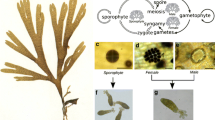Abstract
In the heterothallic strains NC4 and HM1 ofDictyostelium discoideum, sexual development is initiated by the formation of diploid zygotic giant cells produced through the fusion of these two opposite mating-type haploid cells. For sexual cell fusion, amoeboid cells must first acquire fusion competence, which requires culture under certain environmental conditions, such as darkness, excessive water, and sufficient bacteria as food. However, in the subsequent stages of cell fusion and development of the giant cells into mature macrocysts, cells do not require the above conditions. Cell fusion and development into macrocysts were able to occur even in light with minimum water and in the absence of bacteria. For cell fusion calcium ions were required.
Similar content being viewed by others
References
Blaskovics, J.C. andK.B. Raper. 1957. Encystment stages ofD. discoideum. Biol. Bull.113: 58–88.
Bonner, J.T. 1947. Evidence for the formation of cell aggregates by chemotaxis in the development of the slime moldDictyostelium discoideum. J. Exp. Zool.106: 1–26.
Chagla, A.H., K.E. Lewis andD.H. O'Day. 1980. Ca++ and cell fusion during sexual development in liquid cultures ofDictyostelium discoideum. Exp. Cell Res.126: 501–505.
Clark, M.A., D. Francis andR. Eisenberg. 1973. Mating types in cellular slime molds. Biochem. Biophys. Res. Comm.52: 672–678.
Erdos, G.W., K.B. Raper andL.K. Vogen. 1973. Mating types and macrocyst formation inDictyostelium discoideum. Proc. Nat. Acad. Sci. USA70: 1828–1830.
—— and —. 1976. Effects of light and temperature on macrocyst formation in paired mating types ofDictyostelium discoideum. J. Bact.128: 495–497.
McConachie, D.R. andD.H. O'Day. 1986. The immediate induction of extensive cell fusion by Ca++ addition inDictyostelium discoideum. Biochem. Cell Biol.64: 1281–1287.
MacInnes, M.A. andD. Francis. 1974. Meiosis inDictyostelium mucoroides. Nature251: 321–323.
Nickerson, A.W. andK.B. Raper. 1973. Macrocysts in the life cycle of theDictyosteliaceae. I. Formation of the macrocysts. Amer. J. Bot.60: 190–197.
O'Day, D.H. 1979. Aggregation during sexual development inDictyostelium discoideum. Can. J. Microbiol.25: 1416–1426.
Okada, H., Y. Hirota, R. Moriyama, Y. Saga andK. Yanagisawa. 1986. Nuclear fusion in multinucleated giant cells during the sexual development ofDictyostelium discoideum. Dev. Biol.118: 95–102.
Saga, Y. andK. Yanagisawa. 1982. Macrocyst development inDictyostelium discoideum. I. Induction of synchronous development by giant cells and biochemical analysis. J. Cell Sci.55: 341–352.
—. 1983. Macrocyst development inDictyostelium discoideum. II. Mating-type-specific cell fusion and acquisition of fusion-competence. J. Cell Sci.60: 157–168.
Sussman, M. 1966. Biochemical and genetic methods in the study of cellular slime mold development.In D. Prescott, ed., Methods in Cell Physiology, vol. 2, pp. 391–410. Academic Press, New York.
Author information
Authors and Affiliations
Rights and permissions
About this article
Cite this article
Suzuki, K., Yanagisawa, K. Environmental factors inducing sexual development inDictyostelium discoideum . Bot. Mag. Tokyo 102, 53–61 (1989). https://doi.org/10.1007/BF02488112
Received:
Accepted:
Issue Date:
DOI: https://doi.org/10.1007/BF02488112




